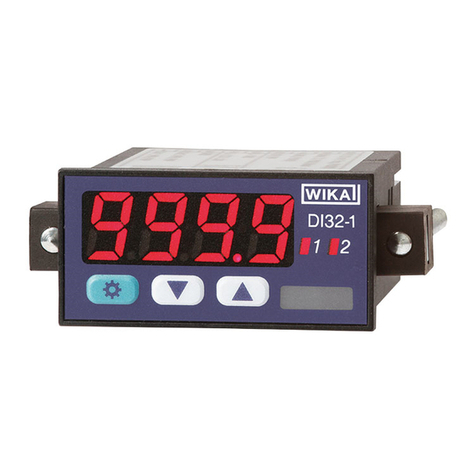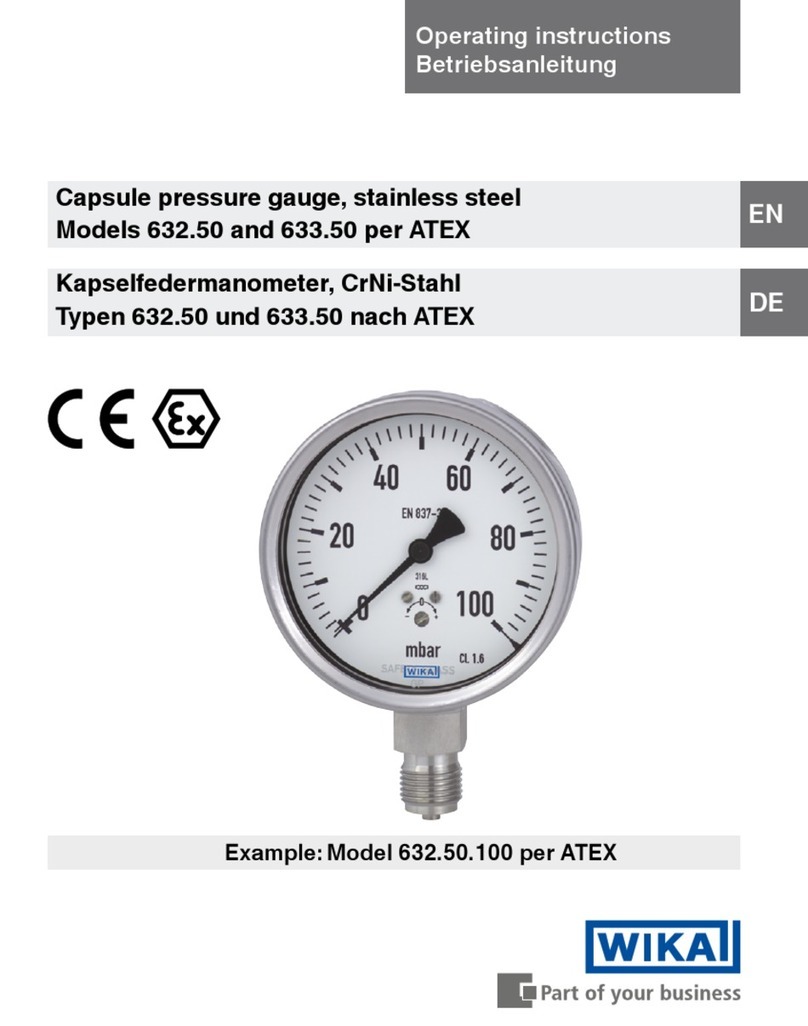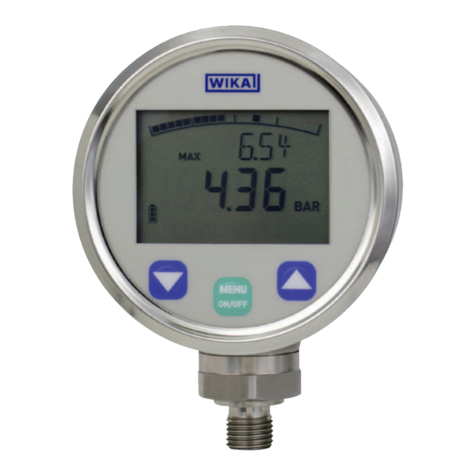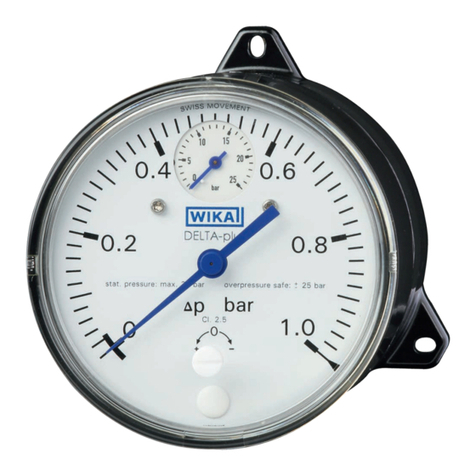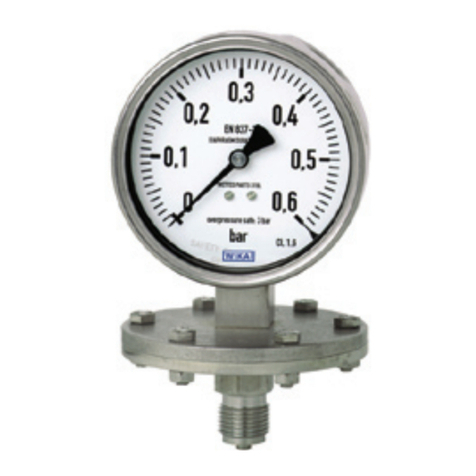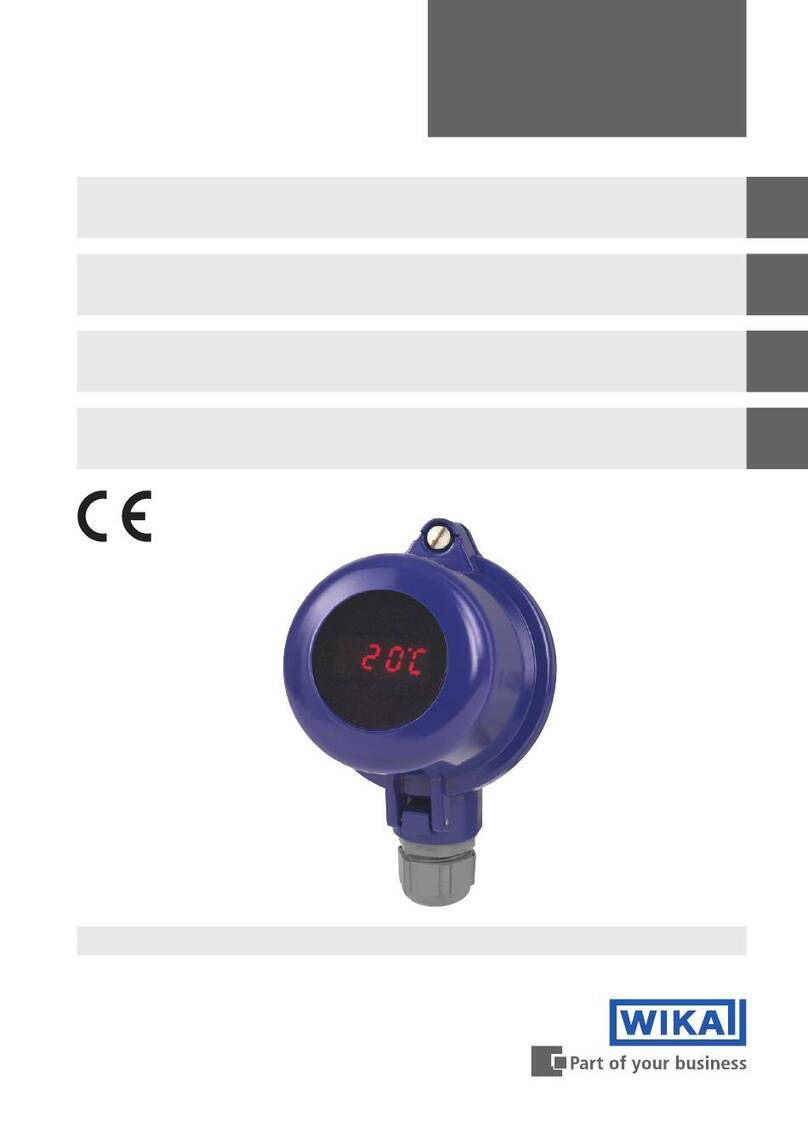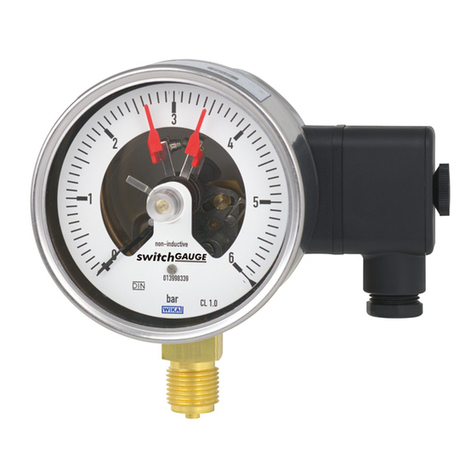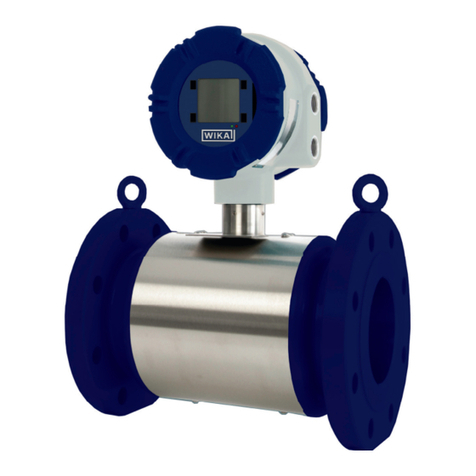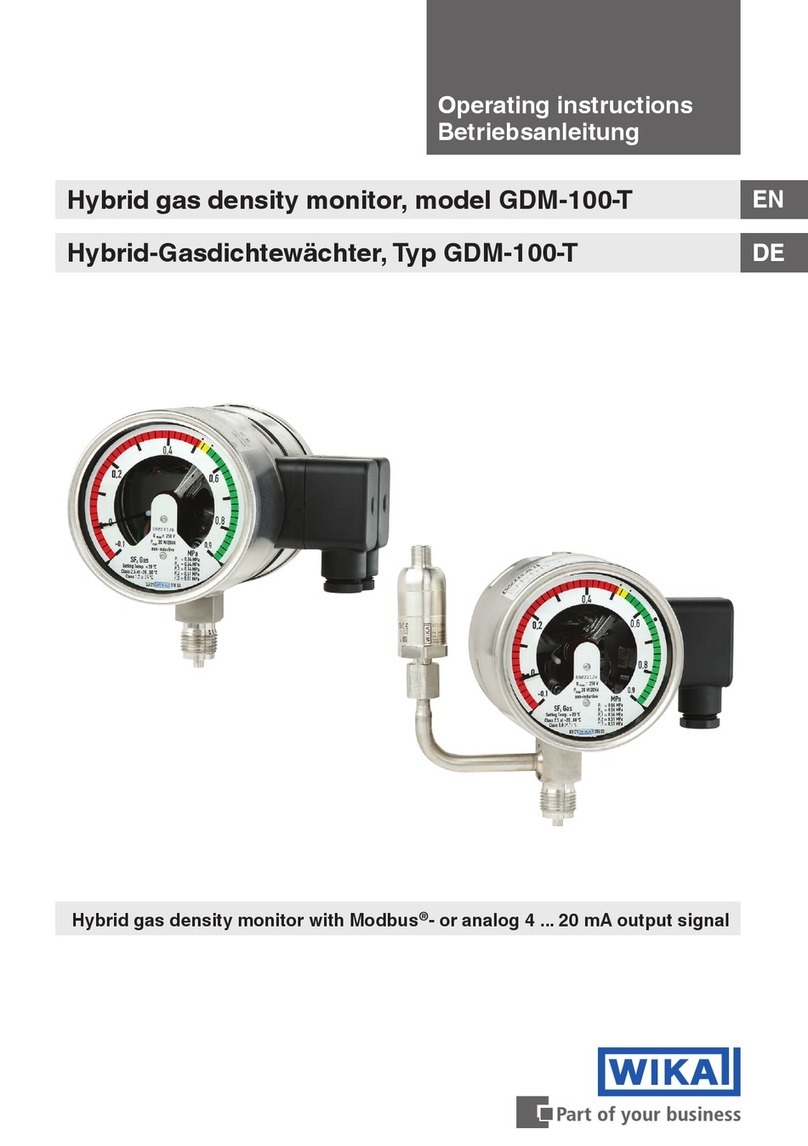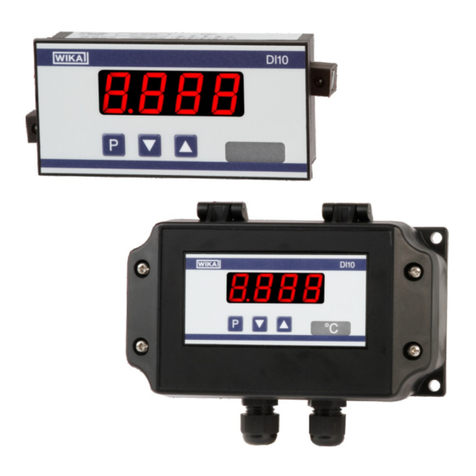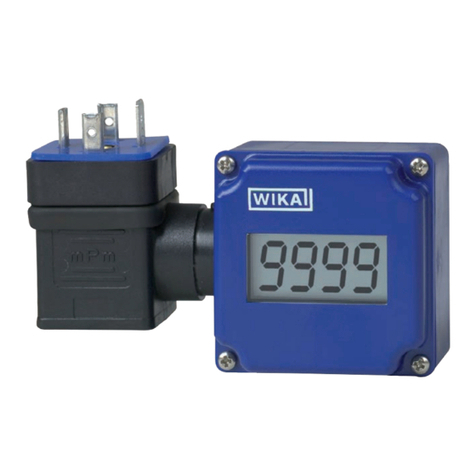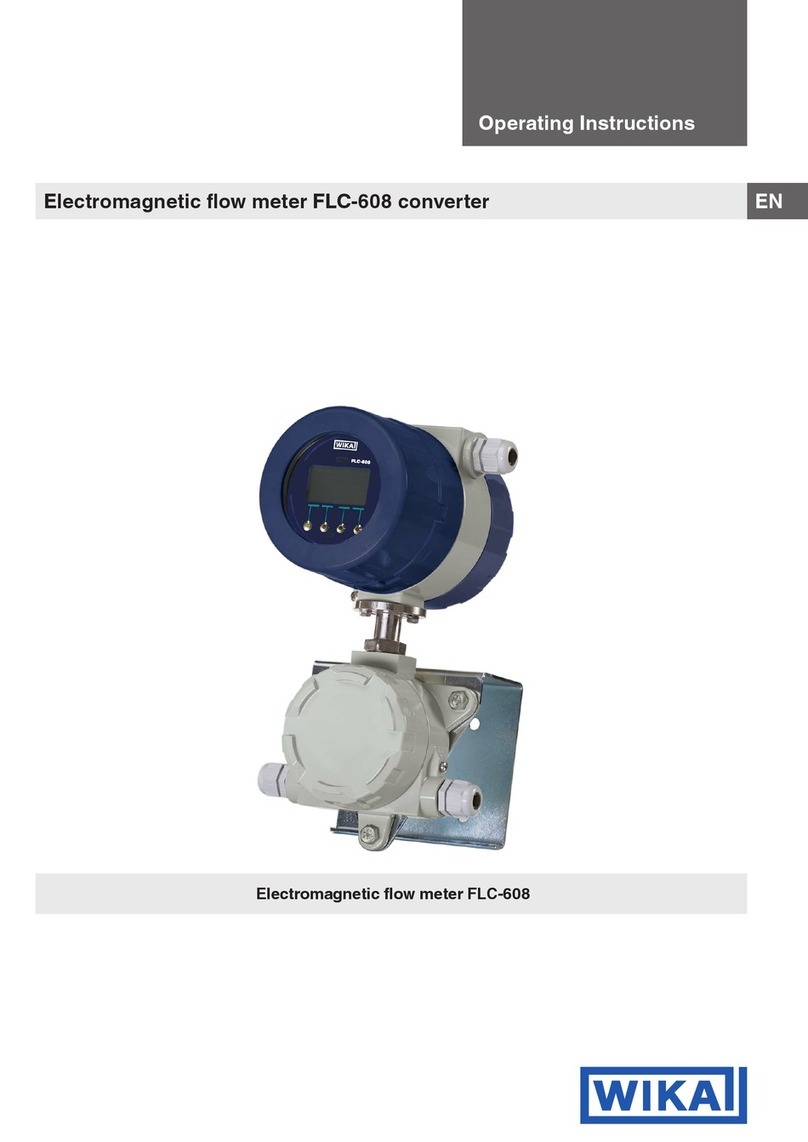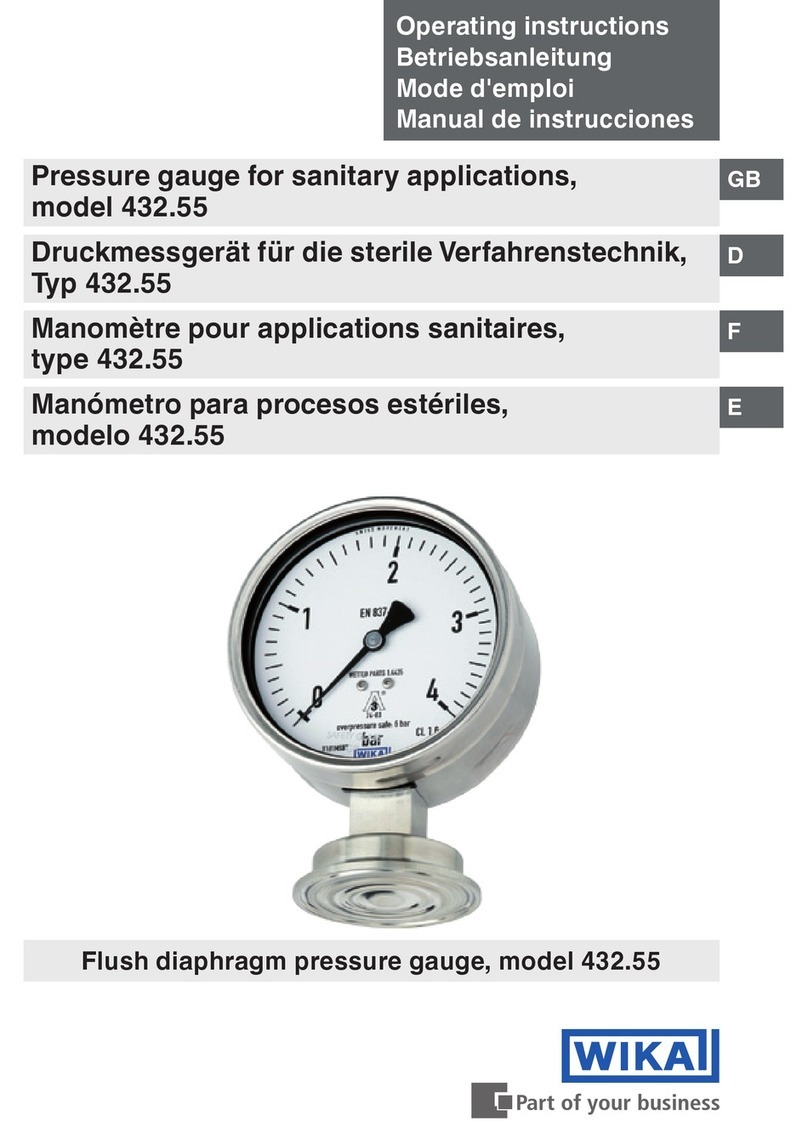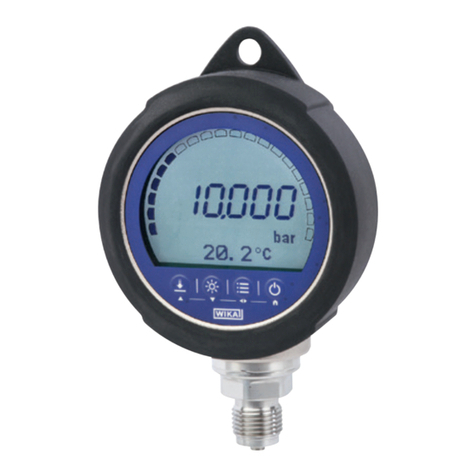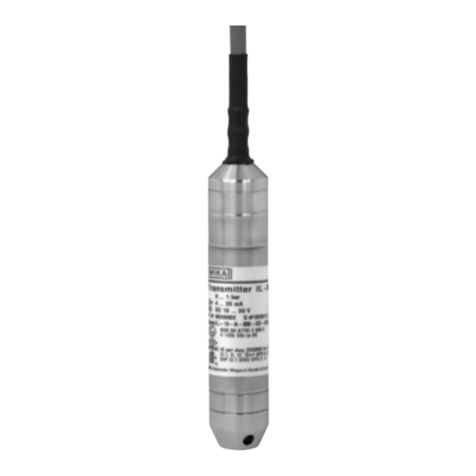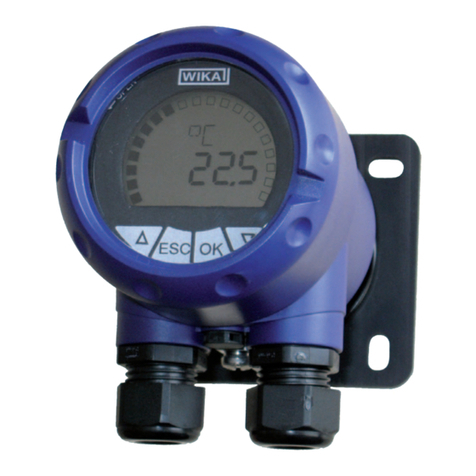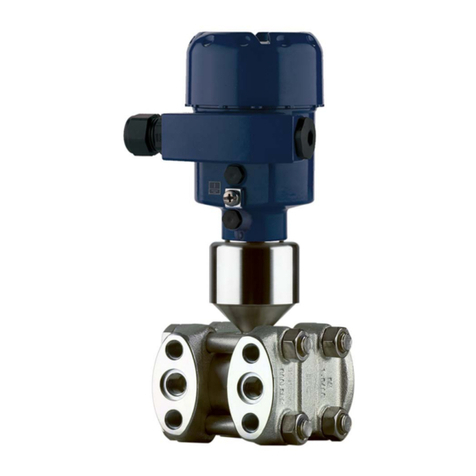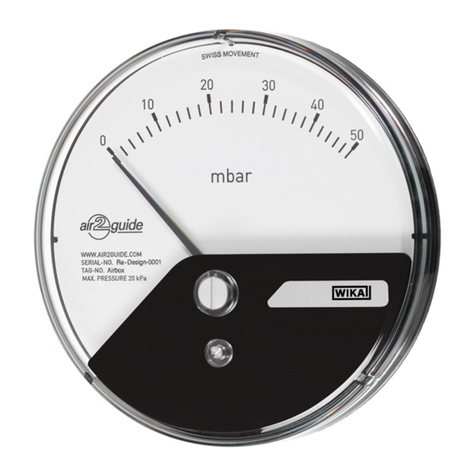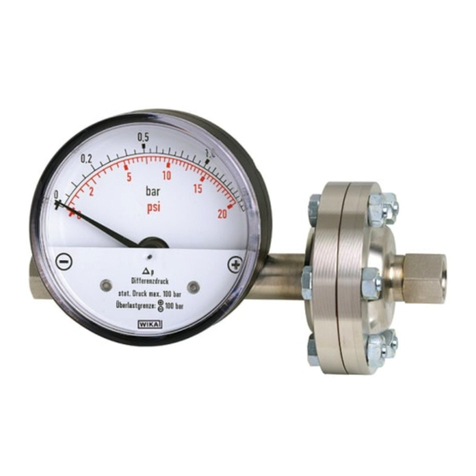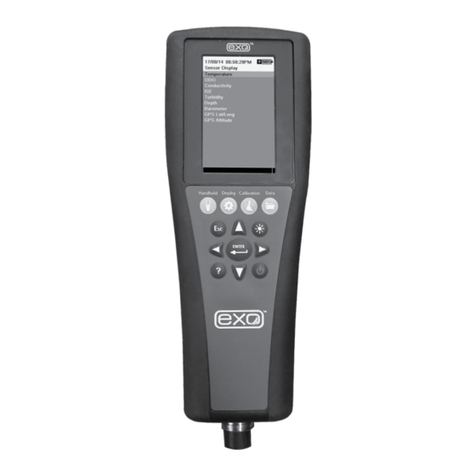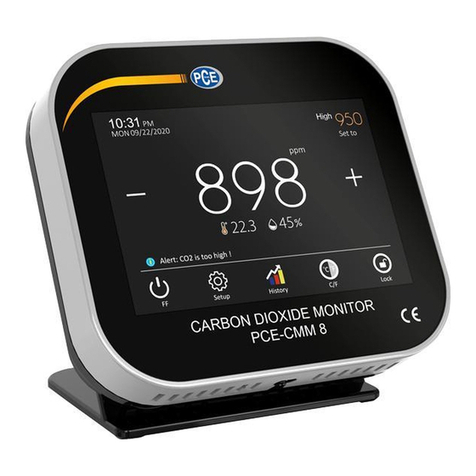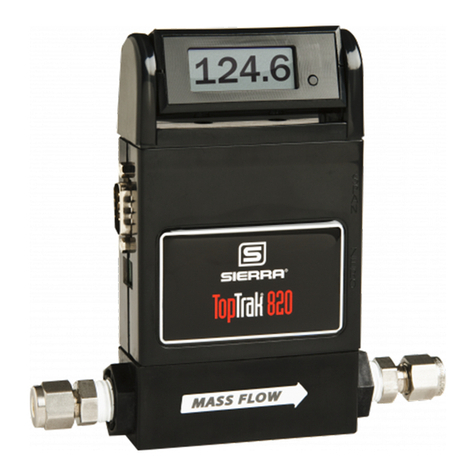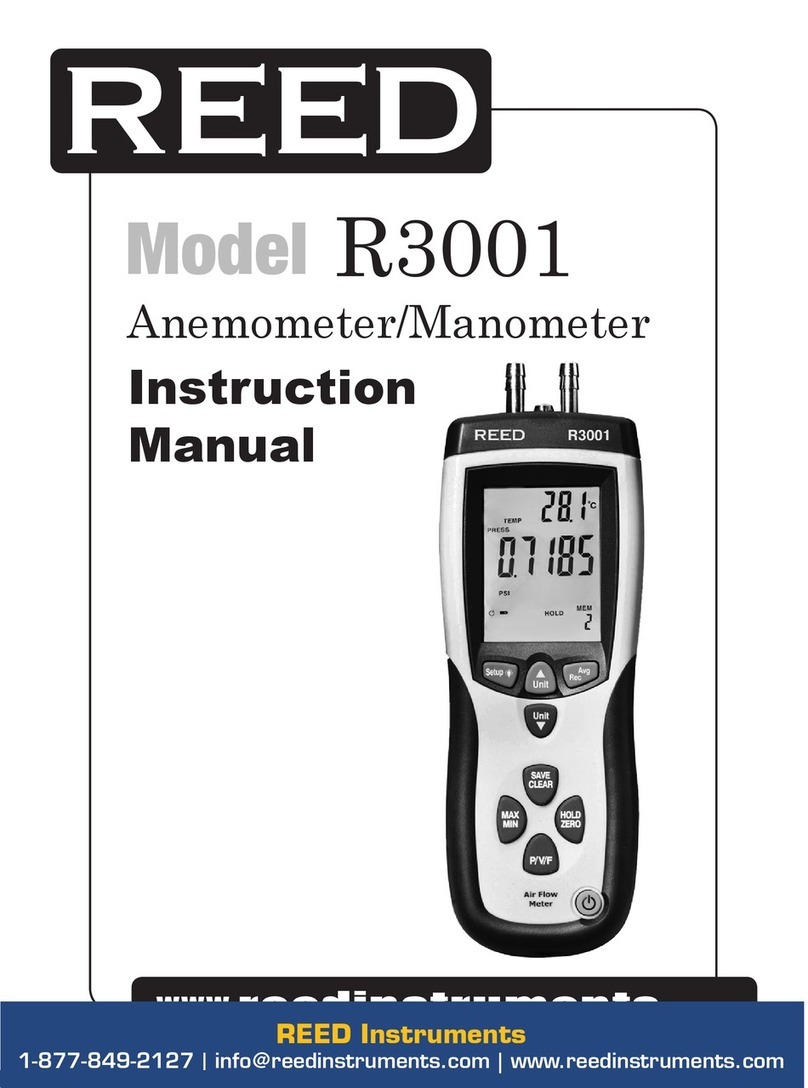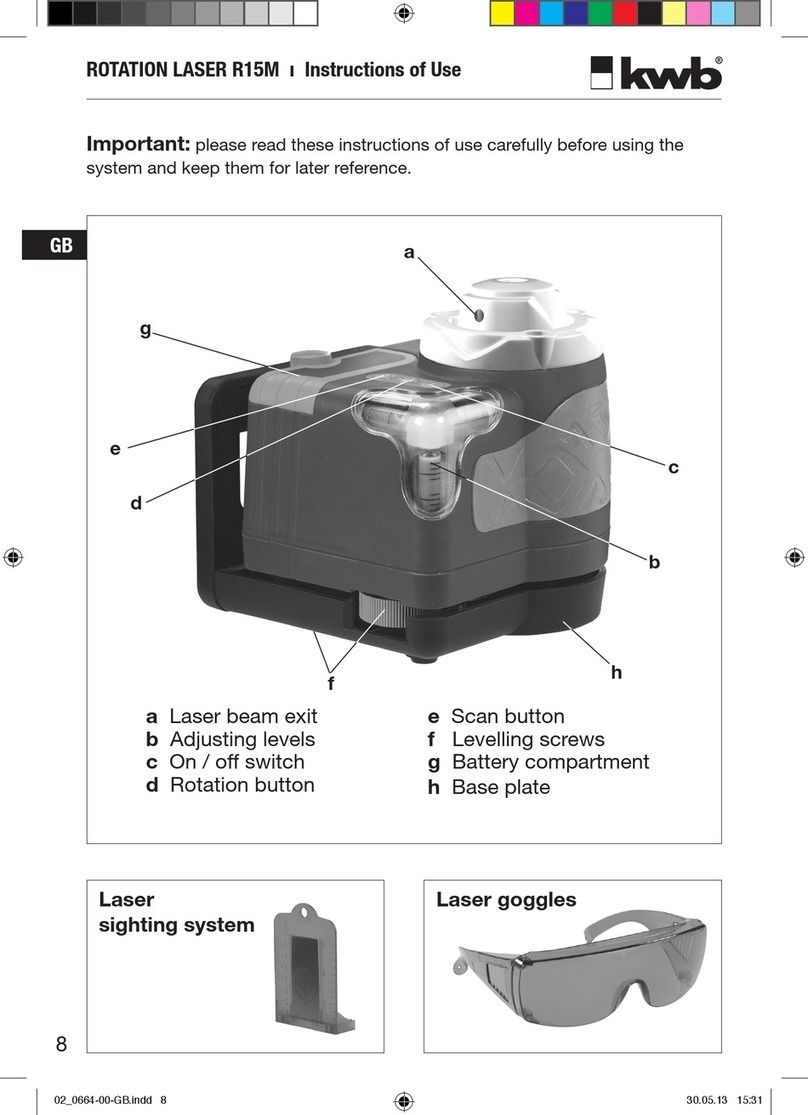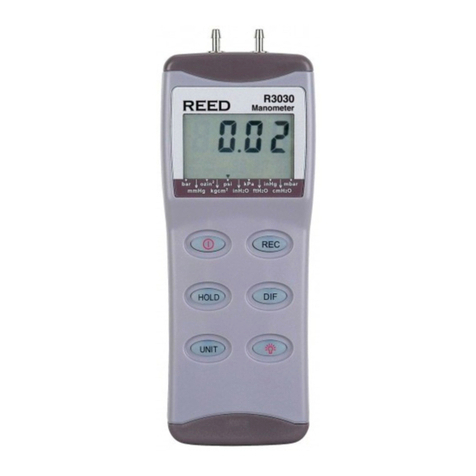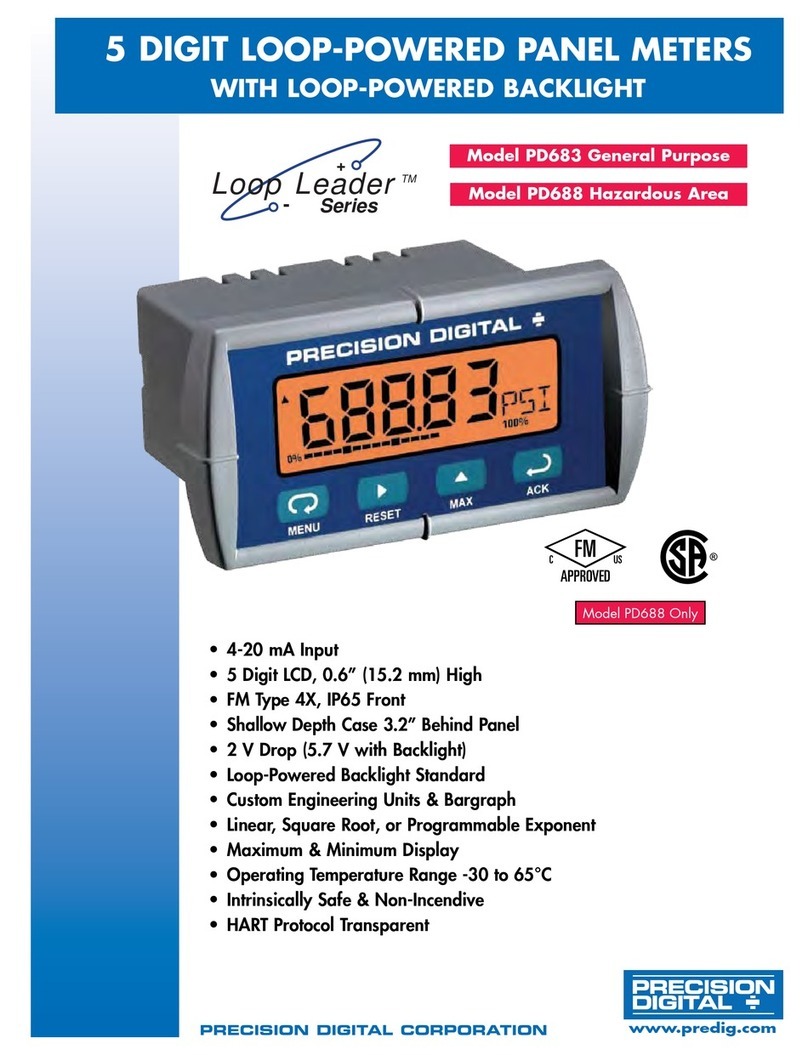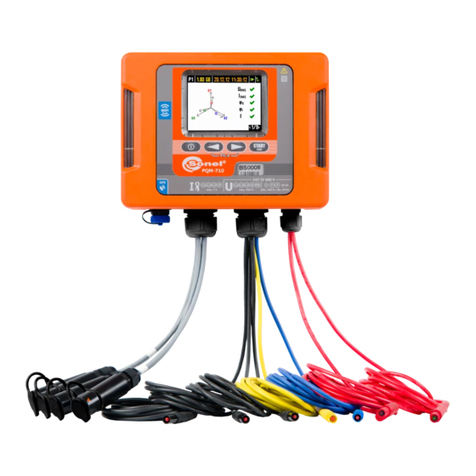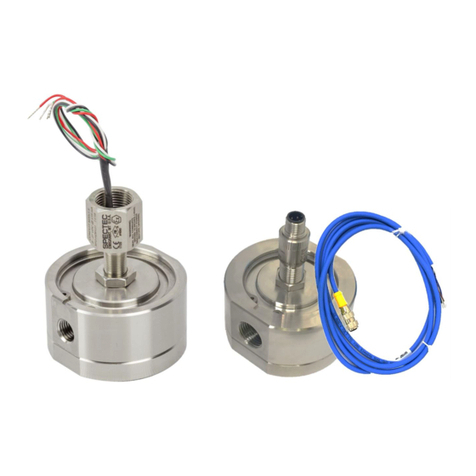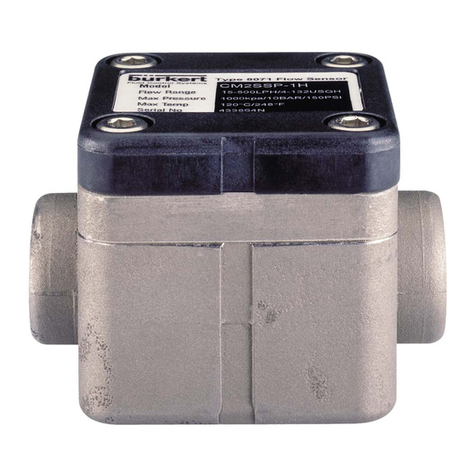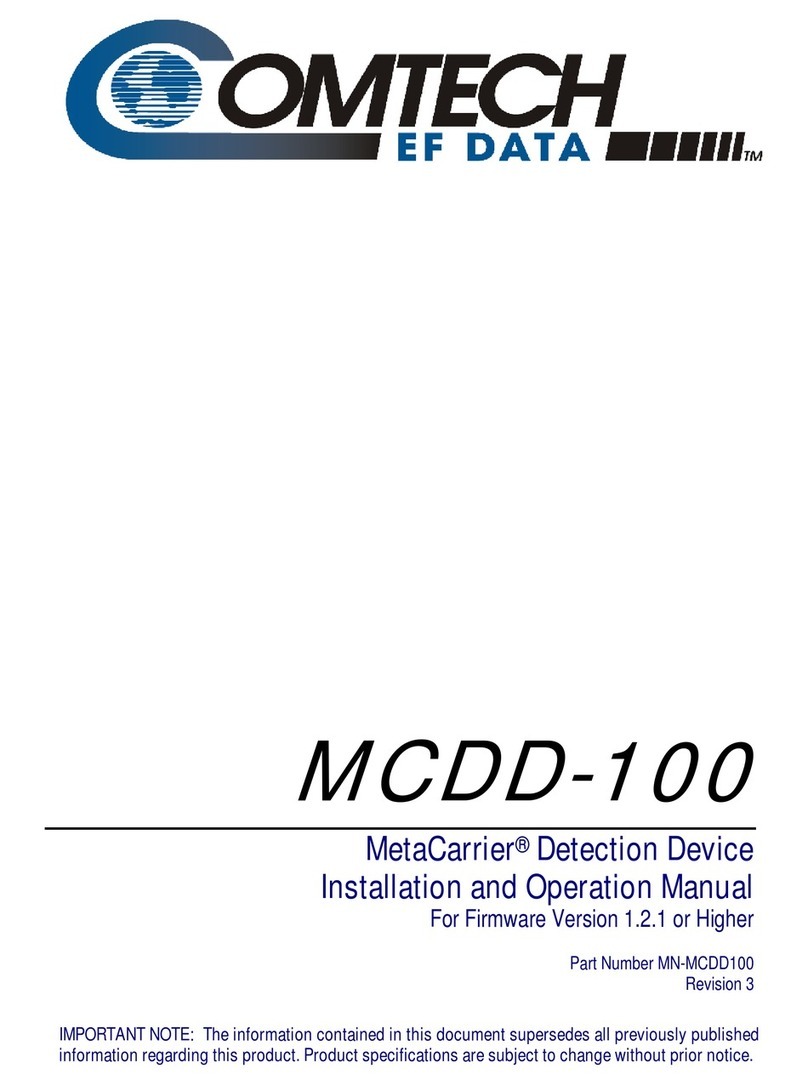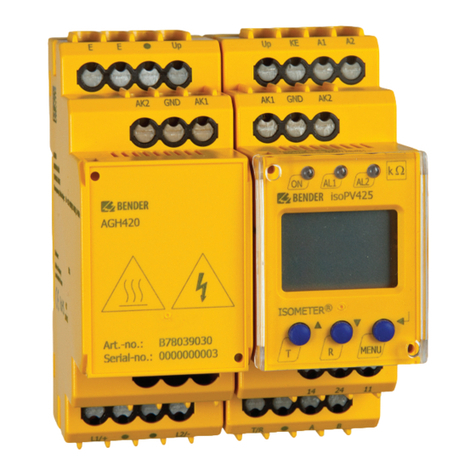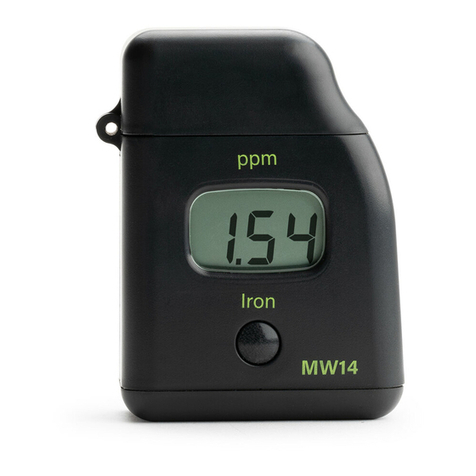WIKA FLC-2300 User manual

Operating Instructions
ENElectromagnetic flow meters sensor bodies
Electromagnetic flow meter FLC-2300

2WIKA Operating Instructions - Electromagnetic flow meter sensors
81500987.02 08/2023 EN
EN
Prior to starting any work, read the operating instructions!
Keep for later use!
WIKA Operating Instructions - Electromagnetic flow
meter sensors Page 3 - 38
Additional languages available on www.wika.com

3WIKA Operating Instructions - Electromagnetic flow meter sensor bodies
81500987.02 08/2023 EN
EN
Contents
Table of contents
1. Introduction 5
1.1 Conventions . . . . . . . . . . . . . . . . . . . . . . . . . . . . . . 5
1.2 General information. . . . . . . . . . . . . . . . . . . . . . . . . . . . 5
1.3 Manufacturer’s statement . . . . . . . . . . . . . . . . . . . . . . . . . . 5
1.4 Packing verification . . . . . . . . . . . . . . . . . . . . . . . . . . . . 5
1.5 Preliminary notes . . . . . . . . . . . . . . . . . . . . . . . . . . . . 6
1.6 Product identification . . . . . . . . . . . . . . . . . . . . . . . . . . . 6
1.7 Applications . . . . . . . . . . . . . . . . . . . . . . . . . . . . . . 7
2. Product description 8
2.1 Operating principle . . . . . . . . . . . . . . . . . . . . . . . . . . . . 8
2.1.1 Bidirectional reading . . . . . . . . . . . . . . . . . . . . . . . . . . . . . . . . . . . . . . . . . . . .8
2.2 Available versions . . . . . . . . . . . . . . . . . . . . . . . . . . . . 8
2.2.1 Flanged sensors . . . . . . . . . . . . . . . . . . . . . . . . . . . . . . . . . . . . . . . . . . . . . .8
2.2.2 Wafer sensors . . . . . . . . . . . . . . . . . . . . . . . . . . . . . . . . . . . . . . . . . . . . . . . 8
2.2.3 Insertion sensors . . . . . . . . . . . . . . . . . . . . . . . . . . . . . . . . . . . . . . . . . . . . . 8
2.3 Type of installation of the sensor . . . . . . . . . . . . . . . . . . . . . . . 9
3. Installation 10
3.1 Storage . . . . . . . . . . . . . . . . . . . . . . . . . . . . . . . . 10
3.2 Moving . . . . . . . . . . . . . . . . . . . . . . . . . . . . . . . . 10
3.3 General installation requirements . . . . . . . . . . . . . . . . . . . . . . . 11
3.3.1 Vibrations . . . . . . . . . . . . . . . . . . . . . . . . . . . . . . . . . . . . . . . . . . . . . . . . . 11
3.3.2 Magnetic fields . . . . . . . . . . . . . . . . . . . . . . . . . . . . . . . . . . . . . . . . . . . . . . 11
3.3.3 Negative pressure . . . . . . . . . . . . . . . . . . . . . . . . . . . . . . . . . . . . . . . . . . . . 11
3.3.4 Protection from direct sunlight . . . . . . . . . . . . . . . . . . . . . . . . . . . . . . . . . . . . . 11
3.3.5 Operating temperatures . . . . . . . . . . . . . . . . . . . . . . . . . . . . . . . . . . . . . . . . . 12
3.4 Installation conditions . . . . . . . . . . . . . . . . . . . . . . . . . . . 12
3.4.1 Positioning in relation to the plant. . . . . . . . . . . . . . . . . . . . . . . . . . . . . . . . . . . . 12
3.4.2 Important guidelines for correct installation . . . . . . . . . . . . . . . . . . . . . . . . . . . . . . 13
3.5 Installation . . . . . . . . . . . . . . . . . . . . . . . . . . . . . . . 15
3.5.1 Important instructions on installation . . . . . . . . . . . . . . . . . . . . . . . . . . . . . . . . . . 15
3.5.2 Sensor support. . . . . . . . . . . . . . . . . . . . . . . . . . . . . . . . . . . . . . . . . . . . . . 15
3.5.3 Tightening torque . . . . . . . . . . . . . . . . . . . . . . . . . . . . . . . . . . . . . . . . . . . . 16
3.5.3.1 Flanged sensors . . . . . . . . . . . . . . . . . . . . . . . . . . . . . . . . . . . . . . . . . . . 16
3.5.3.2 Wafer sensors . . . . . . . . . . . . . . . . . . . . . . . . . . . . . . . . . . . . . . . . . . . . 16
3.5.4 Underground installations . . . . . . . . . . . . . . . . . . . . . . . . . . . . . . . . . . . . . . . . 17
3.6 How to avoid air pockets in the pipelines. . . . . . . . . . . . . . . . . . . . . 17
3.7 Instructions for diameter reduction. . . . . . . . . . . . . . . . . . . . . . . 18
4. Potential equalization 19
4.1 General indications . . . . . . . . . . . . . . . . . . . . . . . . . . . . 19
4.1.1 SEPARATE version grounding connection. . . . . . . . . . . . . . . . . . . . . . . . . . . . . . . 19
4.1.2 COMPACT version grounding connections . . . . . . . . . . . . . . . . . . . . . . . . . . . . . . 19
4.2 Plastic pipes . . . . . . . . . . . . . . . . . . . . . . . . . . . . . . 19
4.3 Metal pipes . . . . . . . . . . . . . . . . . . . . . . . . . . . . . . 19
4.4 Metal pipes with insulating adapters . . . . . . . . . . . . . . . . . . . . . . 20
4.5 Metal and plastic pipes . . . . . . . . . . . . . . . . . . . . . . . . . . 20
4.6 Pipes equipped with cathodic protection. . . . . . . . . . . . . . . . . . . . . 20

4WIKA Operating Instructions - Electromagnetic flow meter sensor bodies
81500987.02 08/2023 EN
EN
Contents
5. Electrical connection 21
5.1 Separate version sensor connection . . . . . . . . . . . . . . . . . . . . . . 21
5.2 Electrical diagrams . . . . . . . . . . . . . . . . . . . . . . . . . . . . 21
5.2.1 Connection with standard single-shielded electrode cable. . . . . . . . . . . . . . . . . . . . . . 21
5.2.2 Connection with standard double-shielded electrode cable . . . . . . . . . . . . . . . . . . . . . 21
5.3 Separation cables . . . . . . . . . . . . . . . . . . . . . . . . . . . . 22
5.3.1 Optional single-shielded electrode cables - C022. . . . . . . . . . . . . . . . . . . . . . . . . . . 22
5.3.2 Optional double-shielded electrode cables - C028 . . . . . . . . . . . . . . . . . . . . . . . . . . 22
6. Pressure tap 22
7. Insertion meters 23
7.1 Introduction . . . . . . . . . . . . . . . . . . . . . . . . . . . . . . 23
7.1.1 Operating principle. . . . . . . . . . . . . . . . . . . . . . . . . . . . . . . . . . . . . . . . . . . . 23
7.2 General installation requirements . . . . . . . . . . . . . . . . . . . . . . . 23
7.2.1 Care of the device . . . . . . . . . . . . . . . . . . . . . . . . . . . . . . . . . . . . . . . . . . . . 24
7.2.2 Alignment of the electrodes in relation to the flow . . . . . . . . . . . . . . . . . . . . . . . . . . . 24
7.3 FLC-1222 . . . . . . . . . . . . . . . . . . . . . . . . . . . . . . . 25
7.3.1 Dimensions and main features . . . . . . . . . . . . . . . . . . . . . . . . . . . . . . . . . . . . . 25
7.3.2 Calculation of the insertion depth. . . . . . . . . . . . . . . . . . . . . . . . . . . . . . . . . . . . 26
7.3.3 Installation of the sensor . . . . . . . . . . . . . . . . . . . . . . . . . . . . . . . . . . . . . . . . 27
7.3.3.1 Preparation of the pipe. . . . . . . . . . . . . . . . . . . . . . . . . . . . . . . . . . . . . . . . 27
7.3.3.2 Assembly of the flow meter . . . . . . . . . . . . . . . . . . . . . . . . . . . . . . . . . . . . . 27
7.3.4 Installation on non-metallic pipes using a saddle bracket . . . . . . . . . . . . . . . . . . . . . . 28
7.3.5 Flow meter grounding . . . . . . . . . . . . . . . . . . . . . . . . . . . . . . . . . . . . . . . . . . 28
7.4 FLC-2660 . . . . . . . . . . . . . . . . . . . . . . . . . . . . . . . 29
7.4.1 Dimensions and main features . . . . . . . . . . . . . . . . . . . . . . . . . . . . . . . . . . . . . 29
7.4.2 Calculation of the insertion depth. . . . . . . . . . . . . . . . . . . . . . . . . . . . . . . . . . . . 30
7.4.3 Installation of the sensor . . . . . . . . . . . . . . . . . . . . . . . . . . . . . . . . . . . . . . . . 31
7.4.3.1 Preparation of the pipe. . . . . . . . . . . . . . . . . . . . . . . . . . . . . . . . . . . . . . . . 31
7.4.3.2 Installation of the flow meter. . . . . . . . . . . . . . . . . . . . . . . . . . . . . . . . . . . . . 31
7.4.4 Flow meter grounding . . . . . . . . . . . . . . . . . . . . . . . . . . . . . . . . . . . . . . . . . . 32
7.5 FLC-2770 . . . . . . . . . . . . . . . . . . . . . . . . . . . . . . . 32
7.5.1 Dimensions and main features . . . . . . . . . . . . . . . . . . . . . . . . . . . . . . . . . . . . . 32
7.5.2 Calculation of the insertion depth. . . . . . . . . . . . . . . . . . . . . . . . . . . . . . . . . . . . 33
7.5.3 Installation of the sensor . . . . . . . . . . . . . . . . . . . . . . . . . . . . . . . . . . . . . . . . 34
7.5.3.1 Preparation of the pipe. . . . . . . . . . . . . . . . . . . . . . . . . . . . . . . . . . . . . . . . 34
7.5.3.2 Installation of the flow meter. . . . . . . . . . . . . . . . . . . . . . . . . . . . . . . . . . . . . 34
7.5.4 Flow meter grounding . . . . . . . . . . . . . . . . . . . . . . . . . . . . . . . . . . . . . . . . . . 35
8. Maintenance 35
8.1 Bolt tightening . . . . . . . . . . . . . . . . . . . . . . . . . . . . . 35
8.2 Grounding check . . . . . . . . . . . . . . . . . . . . . . . . . . . . 35
8.3 Cleaning of ebonite coatings. . . . . . . . . . . . . . . . . . . . . . . . . 35
9. Troubleshooting 35
10.Certifications and technical features 36
11. Return goods 36
11.1 Repair request form. . . . . . . . . . . . . . . . . . . . . . . . . . . . 36
12.Product disposal 37

5WIKA Operating Instructions - Electromagnetic flow meter sensor bodies
81500987.02 08/2023 EN
EN
1. Introduction
1. Introduction
1.1 Conventions
In order to draw the attention of all personnel working with
the equipment supplied by Euromisure, the points of
particular importance described in this manual are highlighted
withgraphic signs that will make them easily identifiable.
CAUTION!
... indicates a risk of electric shock!
All operations marked with this sign must be
performed exclusively by qualified technical
personnel.
CAUTION / WARNING!
...indicates vital information and points to be
observed. Please refer to the related documents.
NOTE
...indicates information and points of particular
importance to be observed.
1.2 General information
IMPORTANT WARNING!
It is very important that all personnel working
with the equipment have read and understood
the instructions and indications provided in this
manual, and that they follow them prior to using
the equipment itself. The manufacturer assumes
no responsibility for the consequences resulting
from improper use by the worker.
The suitability of the device for particular purposes shall be
the worker’s responsibility.
The warranty will be considered void in cases of improper
installation and use of devices (systems).
■The manufacturer shall bear no responsibility for any
damage caused by improper use, improper installation,
or tampering of own products. Installation, connection,
commissioning and maintenance must be carried out
by personnel who are qualified and authorized for this
purpose.The personnel in charge of the installation must
make sure that the measurement system is properly
connected as per the wiring diagram indicated in this
document.
■The manufacturer shall bear no responsibility for any
damages or injuries resulting from any misunderstanding
of this manual. In order to avoid possible accidents to
persons or things caused by incorrect interpretation
of the instructions, the user must not proceed with
operations and/or interventions on the converter if there
are uncertainties or doubts regarding the operation(s)
to be performed. We recommend contacting Assistance
Service for clarifications in this regard for more precise
instructions.
■The manufacturer will be held responsible only if the
converter will be used in its original configuration.
For applications that require high working pressures
or use of substances that may be dangerous for people,
the environment, equipment, or anything else: in case of
pipe breakage, Euromisure recommends taking necessary
precautions, such as adequate positioning and protection
or installation of a guard or safety valve, before installing the
CONVERTER in the COMPACT version.
The device contains live electrical components; therefore,
installation, checks and maintenance must be carried out
by experienced and qualified personnel who are aware of
all necessary precautions to be taken. Before opening any
internal part, please disconnect the power supply.
1.3 Manufacturer’s statement
■Stresses and loads possibly caused by earthquakes,
strong winds, fire damage, vibrations and natural disasters
were not taken into account in the phase of machine
designing.
■Do not install the machine in such a way that it acts as a
focus for pressure on the pipes. External loads were not
taken into account in the device configuration.
■While the device is working, the pressure, supply voltage
and/or temperature values indicated on the label or in this
Operating Manual must not be exceeded.
1.4 Packing verification
At the moment of purchase and/or upon receipt of the
product, the buyer is strongly advised to check the quality
of the packaging, which must be intact, without visible dents,
and completely and correctly closed.
When opening the packaging, also check that the product
complies with the information on the packing list in terms of
completeness of components/accessories.
NOTE
All Euromisure software are available on the USB
stick that accompanies the product. The software
can also be downloaded from the website
www.wika.com by accessing the Download Area.
A free registration will be required, after which
you can download the configuration software
for your product.

6WIKA Operating Instructions - Electromagnetic flow meter sensor bodies
81500987.02 08/2023 EN
EN
1. Introduction
1.5 Preliminary notes
Main parts of the electromagnetic flowmeter are:
■Sensor – installed in the tube with the use of flanges and
other joints;
■Converter – can be installed on the sensor (in compact
version) or remotely (in remote version) connected with
two pipes.
Electromagnetic flow meters have many important
advantages compared to their mechanical counterparts,
such as exceptional long-term stability, maximum process
reliability, and zero maintenance. As a result, these sensors
can provide accurate and reliable long-term measurements.
See the following paragraphs for more detailed information
on correct installation.
NOTE
Electromagnetic flow meters are designed
specifically to operate under the following basic
conditions:
▶the liquid must be conductive;
▶pipe must be always full and free from air and
bubbles;
▶the input and output distances must be on
recommended settings;
▶The grounding instructions must be followed.
1.6 Product identification
Each Sensor manufactured by Euromisure has an
identification plate (Fig. 1) that displays the following
information:
■MODEL: Sensor model;
■S/N: Sensor identification number;
■DN: Nominal diameter [inches or mm];
■PN: Nominal pressure;
■TEMP.: Maximum liquid temperature for process completion;
■IP: International degree of protection
■ELECTRODES: Electrodes material composition
■LINING: Lining material
■KA: Calibration coefficient
■CE: Marking
Fig. 1: Identification plate
NOTE
The identification plate must never be removed,
damaged, or changed. It must also be kept clean
from any dirt deposits, as the data contained are
the only safe and unambiguous way to recognize
the type of converter and be able to complete
the repair request form attached to this manual.

7WIKA Operating Instructions - Electromagnetic flow meter sensor bodies
81500987.02 08/2023 EN
EN
1. Introduction
1.7 Applications
The sensors manufactured by the company Euromisure are widely used in many applications where it is important to measure
the flow rate of electrically conductive liquids.Various models can be used in different applications. The table below shows the
typical applications according to the individual sensor models manufactured by Euromisure.
Applications Sensor model
FLC-2200EL
/ US
FLC-2300
/ US
FLC-1000EL
/ US
FLC-1100J FLC-1222 FLC-2660 FLC-2770
Wastewater X X X X
Industrial drainage water X X X X
Industrial wastewater X X X
Data acquisition for report and
analysis
XXXXXXX
Night applications with very low
flow rates
X
Leakage control X X X X
Dams X X
Water distribution X X X
Distribution, municipal waters X
Sludge X
Water network management X X X
Flow monitoring X X X
Industrial liquids X X X X X
Installation in small spaces
without linear distances
X
Irrigation X X X
Process liquids, sludge,
and concrete
X X X X X
Mines X X
District measure X X X
Drinking or wastewater
measurement
XXX
Tax measures X X
Industrial processes X X X X X X X
Flow profiling X X X
Leakage detection X X
Building sector X X
Fire-fighting systems X X
Refrigeration systems X X
Pumping stations X X
Water treatment X X
Verification of flow meters on site X X X

8WIKA Operating Instructions - Electromagnetic flow meter sensor bodies
81500987.02 08/2023 EN
EN
2. Product description
2.1 Operating principle
The eltctromagnetic sensor is used to measure
the flow rate of liquids (drinking water, wastewater, beverages,
fertilizers, chemical products, and any other liquid) that have
an electrical conductivity of at least 5 μS/cm.
Electromagnetic flow meters are the best solution for measuring
the flow rate liquids because of fast response times, great
measurement accuracy, and a passage tube that does not
present any obstruction to the liquid flow, therefore no pressure
drop in the pipe. Furthermore, since they do not use any moving
parts, they require virtually no maintenance. Euromisure
eltctromagnetic flow meters cover a wide variety of applications
(e.g., water flow meters, wastewater flow measurement, fertilizer
flow measurement, etc.) and respond
to every customer request thanks to the wide range of models.
Meters are available in wafer, flanged, threaded, and insertion
versions from DN6 to DN2000 in pressure class up to ANSI900.
NOTE
In order to perform its measuring function,
the sensor must be combined with a converter.
The converters are designed to meet all the needs of modern
water management systems through flexible and hybrid
electronics, which, depending on the model, offers various
electrical power solutions.
At the ends of a conductive fluid that moves with speed vin a
magnetic field Ban electromotive force e is induced and can be
expressed as:
e = kBDv
Where:
■Bis constant by construction;
■Dis constant and represents the distance between the
electrodes E1 and E2 (equivalent to the flow meter diameter);
■vis the speed of the liquid;
■kis the calibration constant.
The electromotive force «e» is proportional to the speed
«v».
1Electromotive force (proportional to the speed)
2Electrodes
3Magnetic field
4Coils
1
2
3
4
2. Product description
2.1.1 Bidirectional reading
The sensor has a possibility of bidirectional reading (i.e., it is able
to read the flow of the liquid in both directions).
By convention, the sensor will output positive values if the liquid
flows:
■in the same direction as the arrow (enters in – and exits
in +), the flow is positive, and the display will show a reading
without a sign;
■in the opposite direction to that indicated by the arrow
(enters in + and exits in -), the flow is negative, and the
display will show a reading with a negative sign.
Direct flow -> number without
sign
Reverse flow -> negative
number
2.2 Available versions
Euromisure manufactures its sensors in different versions,
each intended for use in different applications, as
summarized in the paragraph “1.7 Applications.”
The different sensor versions available are shown below.
2.2.1 Flanged sensors
■FLC-2200EL – Full Bore
■FLC-2300 – Reduced Bore
2.2.2 Wafer sensors
■FLC-1000EL - Wafer
■FLC-1100J - Wafer in plastic material
2.2.3 Insertion sensors
■FLC-1222
■FLC-2660
■FLC-2770

9WIKA Operating Instructions - Electromagnetic flow meter sensor bodies
81500987.02 08/2023 EN
EN
2. Product description
2.3 Type of installation of the sensor
The sensors in different versions can be connected to the converter in two different ways, namely:
Installation Flanged Sensors Wafer Sensors Insertion Sensors
COMPACT installation
The sensor is connected directly
to the related converter.
SEPARATE installation
[remote]
The sensor is connected to the
converter by specific power/signal
cables.

10 WIKA Operating Instructions - Electromagnetic flow meter sensor bodies
81500987.02 08/2023 EN
EN
3. Installation
3. Installation
3.1 Storage
NOTE
To ensure the correct maintenance of the device
while waiting for its installation, it is necessary
to comply with the storage provisions below:
▶Store the device in a dry place and protected
from dust;
▶Keep away from direct and continued sunlight;
▶Keep the device in the original packaging until
it is used;
▶Temperature of the storage place: -40 ÷ +70 °C
(-40 ÷ +158 °F)
3.2 Moving
CAUTION!
The sensor must be carefully lifted and moved
so as not to cause damage to the sensor itself
and connection flanges. Below you will find a
description of correct and incorrect lifting and
moving.
The proper lifting method (for transport and installation) of the
sensor is shown in Fig. 2. The flow meter must be lifted and
transported by properly harnessing the device on the side
parts of the flow meter, making sure that the slings (ropes,
bands, etc.) are fixed to the appropriate eyebolts.
WARNING!
Do not raise the flow meter harnessing
the converter (Fig. 3)!!
WARNING!
Do not move the flow meter with the lifting
device if it is not in the original packaging (Fig. 4)
or without adequate support that ensures the
required stability.
Fig. 2
Fig. 3
Fig. 4

11WIKA Operating Instructions - Electromagnetic flow meter sensor bodies
81500987.02 08/2023 EN
EN
3.3 General installation requirements
IMPORTANT NOTE
The sensor must always be completely full of
liquid (see Fig. 5)!
Fig. 5: The pipe must always be completely full of liquid
3.3.1 Vibrations
DO NOT expose the flowmeter to vibrations and/or
movements that could affect its performance and duration.
Fig. 6: Avoid vibrations
Install a suitable anti-vibration protection if vibrations occur.
Fig. 7: Installation with anti-vibration protections
3.3.2 Magnetic fields
AVOID exposing the flow meter to strong or nearby magnetic
fields.
Fig. 8: Avoid magnetic fields
3.3.3 Negative pressure
IMPORTANT NOTE
Avoid vacuum conditions in the pipe.These can
damage the coating of the flow meter and move
the electrodes from their correct position.
3.3.4 Protection from direct sunlight
Protect the flow meter if exposed to direct sunlight.
Fig. 9: Avoid direct exposure to sunlight
3. Installation

12 WIKA Operating Instructions - Electromagnetic flow meter sensor bodies
81500987.02 08/2023 EN
EN
3.3.5 Operating temperatures
For normal and efficient operating of the flow meter, the room
temperature must be limited within the range of -25 ÷ +60 °C,
(-13 ÷ +140) °F.
Fig. 10: Environment and fluid temperature limits
Sensor liner and converter
configuration
°C °F
Min. Max. Min. Max.
Coating in EBONITE -40 +80 -40 +176
Coating in PTFE (remote) -40 +130 -40 +266
Coating in PTFE (compact) -40 +80 -40 +176
Coating in PTFE (separate high temperature) -40 +180 -40 +356
FLC-1100J 0 +80 32 +176
Insertions -20 +80 -4 +176
3.4 Installation conditions
3.4.1 Positioning in relation to the plant
NOTE
To ensure optimal working conditions, the flow
meter must be installed correctly inside
the system. Correct and incorrect installation
positions are described and illustrated below.
The flow meter must remain below the hypothetical blue line
(piezometric level line), which connects the two levels of fluid
to be measured (Fig. 11).
NOTE
Avoid placing the flow meter above the
piezometric level line (Fig. 12).
Fig. 11: Correct position
Fig. 12: Incorrect position
3. Installation

13WIKA Operating Instructions - Electromagnetic flow meter sensor bodies
81500987.02 08/2023 EN
EN
3.4.2 Important guidelines for correct installation
NOTE
The junction box on the sensor is designed
to have the IP68 protection degree only when
properly closed and tightened.The manufacturer
does not assume any responsibility for an
improper closing by third parties.
For correct working conditions, please follow the important
guidelines shown in the following figures.
Improper installation may result in an inaccurate measurement.
For partially filled pipes or with downward flow and free exit, the
flow meter should be placed in a U-shaped tube (see Fig. 13).
Full bore Sensors
Reduced bore Sensors
Fig. 13: Installation on U-shaped tube
Fig. 14: Installation of Insertion Sensors on U-shaped tube
Fig. 15: “T” connection downstream of the flow meter
installation on U-shaped tube
Fig. 16: Installation near three-dimensional bends
IMPORTANT NOTE
The sensor must always be completely full of
liquid!
To ensure that the sensor is always completely filled with
liquid, it is important to install it in the correct position ( √)
and avoid all possible incorrect positions ( X).
Fig. 17: √ This installation secures the sensor full of liquid.
Fig. 18: X This installation DOES NOT guarantee a pipe
full of liquid.
3. Installation

14 WIKA Operating Instructions - Electromagnetic flow meter sensor bodies
81500987.02 08/2023 EN
EN
We recommend installing the sensor on a vertical/sloped
pipe with an upward flow direction (Fig. 19) to minimize
the wear and deposits in the sensor.
Avoid the installation on vertical pipes with free exit (Fig. 20).
Fig. 19: Correct position
Fig. 20: Incorrect position
√The position on the left secures the sensor full of liquid.
XCentral and right positions DO NOT guarantee a pipe full
of liquid.
Fig. 21: Correct (LH) and incorrect installation (central
and RH)
We recommend installing gate valves downstream of the
meter.
Fig. 22: Gate valves installation
XIn order to avoid a vacuum, always install the sensor
downstream of the pump and NEVER upstream.
Fig. 23: Avoid negative pressure
XDO NOT install the sensor on vertical pipes with a free
outlet or at the highest point of the pipe system.
Fig. 24: Incorrect installation
3. Installation

15WIKA Operating Instructions - Electromagnetic flow meter sensor bodies
81500987.02 08/2023 EN
EN
3.5 Installation
3.5.1 Important instructions on installation
In case of inadequate distance between the sensor and
the pipe, use elastic pipe fittings (Fig. 25).
Do not try to move the pipe closer to the sensor by tightening
the bolts (Fig. 26).
NOTE
Do not try to move the pipe closer to the sensor by
tightening the bolts.
Fig. 25: Correct fixing
Fig. 26: Incorrect fixing
Also avoid the following positions:
NOTE
Insertion meters can also be installed horizontally.
Fig. 27: Correct position
Fig. 28: Incorrect position
Fig. 29: Incorrect position
Maximum allowable deviation of the pipe flange faces is 0.5 mm.
Fig. 30: Maximum allowable deviation
3.5.2 Sensor support
XDO NOT USE the sensor as a support for the pipe.
Fig. 31: Incorrect installation
√The pipe must be the support for the flow meter.
Fig. 32: Correct installation
3. Installation

16 WIKA Operating Instructions - Electromagnetic flow meter sensor bodies
81500987.02 08/2023 EN
EN
3.5.3 Tightening torque
3.5.3.1 Flanged sensors
Standard bolts must be lubricated well and tightened evenly
around the gasket. If the bolts are overtightened, leakage
or damage to the flow meter or piping may occur.
Fig. 33: Flange tightening
Carefully follow the instructions given in the diagrams.
Check the correct centering of the sensor before you tighten
the flanges and proceed following the steps described here.
■Step 1: ≈ 50% of the maximum tightening torque;
■Step 2: ≈ 80% of the maximum tightening torque;
■Step 3. 100% of the maximum tightening torque given
in the diagram.
All the values are theoretical and have been calculated for
optimal conditions and with the use of carbon steel flanges.
3.5.3.2 Wafer sensors
Fig. 34: Flange tightening
DN PN BOLTS
Maximum tightening torque [Nm]
FLC-2200EL FLC-1000EL FLC-1100J
PTFE Ebonite PTFE Ebonite OR NBR
15 40 4xM12 10 6 - - -
20 40 4xM12 16 10 - - -
25 40 4xM16 20 12 15 - -
32 40 4xM16 35 20 25 - -
40 40 4xM16 45 25 30 - 25
50 40 4xM16 55 30 40 - 35
65 40 8xM16 38 25 30 - 25
80 40 8xM16 45 25 35 - 30
100 16 8xM16 45 25 35 - 30
125 16 8xM16 55 40 45 32 -
150 16 8xM20 70 50 60 45 50
200 10 8xM20 85 70 - 55 -
200 16 12xM20 70 45 - 35 -
250 10 12xM20 80 65 - 50 -
250 16 12xM24 115 80 - 65 -
300 10 12xM20 90 75 - 60 -
300 16 12xM24 145 105 - 85 -
350 10 16xM20 100 75 - - -
400 10 16xM24 140 105 - - -
450 10 20xM24 - 95 - - -
500 10 20xM24 - 110 - - -
600 10 20xM27 - 140 - - -
700 10 20xM27 - 160 - - -
800 10 24xM30 - 220 - - -
900 10 28xM30 - 205 - - -
1000 10 28xM35 - 260 - - -
3. Installation

17WIKA Operating Instructions - Electromagnetic flow meter sensor bodies
81500987.02 08/2023 EN
EN
3. Installation
3.5.4 Underground installations
The remote sensor is protected by IP68 / NEMA 6P and
can be positioned underground. We recommend the use
of gravel for at least 300 mm (12 inches) around the sensor.
This provides drainage and prevents dirt solidification on
the sensor. In addition, it facilitates the location of the same
if new excavations are required. Before covering the gravel
with earth, we recommend using electrical cable identification
tape above the gravel itself. The remote sensor cable should
pass through a plastic conduit.
Fig. 35: Underground installation
3.6 How to avoid air pockets in the pipelines
This paragraph is intended to help the designers and users
of electromagnetic flow meter to create the best installation
layout that guarantees optimum performance of the meter,
taking into particular consideration the problem of the
presence of air pockets in the pipe.
Fig. 36: Pumping stations with flowmeters and vent valves
NOTE
What are the problems caused by the air pockets
entrapped in any flowmeter?
The presence of air pockets can cause serious reading errors
or strong instability. In this case, the flow meter could go into
Error mode (see the related converter manual).
NOTE
How are air pockets removed, or moved away
from the flow meter?
The air pocket inside a pipe always moves toward the top
of the pipe, and it is assumed that the air will always move
if the flow passes along a horizontal pipe, but this is not the
case. Instead, a specific water speed is required to move
the air; the greater the diameter of the pipe, the higher the
airspeed is required to move it away from the flow meter.
Typically, most installations of flow meters are simply sized
on the diameter of the tube or on the flow rate in the pipe,
which means that the speed is often less than 0.5 m/s,
which can be very problematic if the air pockets occur.
As an example in a pipe with zero gradients, these are
the specific water speeds necessary to move away the air
pockets detected in the tube:
■DN50 → 0.4 m/s
■DN150 → 0.7 m/s
■DN300 → 1 m/s
■DN600 → 1.5 m/s
Fig. 37: Air pockets inside the pipe
The greater the diameter of the pipe, the higher the speed
of the liquid will be required to move the air pockets away
from the flow meter. It is also important to understand what
kind of effect the water pressure has on the nature of the air
pocket inside the pipe. The lower the pressure in the tube,
the greater the size of the air pocket is, and the greater
the effect it will have on the performance of the flow meter.
By increasing the pressure in the duct, the air pocket will
compress, causing fewer problems.This can be achieved
by installing pressure control valves after the flow meter to
maintain constant pressure in any situation.
Fig. 38: Example of pressure control valves
One solution is to install the flow meter on a pipe with
an increasing slope so that the entrapped air pocket will
move to the highest point. Then, through special vent valves,
the air will be released from the pipe, maximizing the system
capacity.

18 WIKA Operating Instructions - Electromagnetic flow meter sensor bodies
81500987.02 08/2023 EN
EN
3. Installation
Fig. 39: Pipe with an increasing slope for application
of vent valves
A minimum slope in an ascending flow of 1:500 or higher
is recommended in order to stimulate the entrapped air
pocket to move away from the meter.
Fig. 40: Flow meter with slight ascending slope with air
vent at the top. Drawings are made with an exaggerated
slope for greater clarity
A second solution is to mount the flow meter vertically with an
upward flow stream, which ensures that the air always moves
quickly past the meter.
NOTE - IMPORTANCE OF AIR VENT VALVES
The general principle of each installation is
to ensure that the device is always full of water;
however, this is not always possible since a part
of the network could drain when the pumps are
turned off. It is, therefore, essential to ensure
that the design incorporates a properly designed
and sized air vent valve to release the air when
the pump starts, making sure that the meter
immediately starts reading.
Fig. 41
The design of the vent valve is essential to
ensure that the entrapped air pockets are
released. Pneumatic valves or vacuum switches
should be avoided. Instead, it is preferable to use
combined pneumatic valves that incorporate
an automatic orifice, as well as a large kinetic
orifice.These valves ensure that the largest
volumes of air are released quickly and
effectively while filling the pipe.
Fig. 42: Typical combined air vent valve, designed with
automatic and kinetic air release functions
3.7 Instructions for diameter reduction
NOTE
In the case of diameter reduction, please refer to
the indications shown in the figure (43) below.
Fig. 43: Installation on pipes with diameter reduction
1Vent
2Recommended maximum vertex angle: 15°
3Flow rate meter
4Flow
5Discharge
Flowmeter type U D
Full Bore 5 3
Reduced Bore 0 0
Insertion 15 10
NOTE
The diameter reduction introduces a pressure
drop in the system. Pay attention, especially when
the flow rates are high and if the section reduction
is applied simultaneously with the use of reduced
section meters. In the case of low pressures,
the section reduction could also lead to cavitation
formation, especially if the meter has a reduced
section; this condition must be absolutely avoided.

19WIKA Operating Instructions - Electromagnetic flow meter sensor bodies
81500987.02 08/2023 EN
EN
4. Potential equalization
4. Potential equalization
4.1 General indications
The sensor must be grounded, as shown in the figures
below, using the cables with a minimum section of 2.5 mm2
(recommended: 4 mm2).This will assure the potential bonding,
noise reduction, and, in the case of a metal pipe, it will
guarantee electrical continuity.
Liquid potential equalization or grounding is obtained with
the built-in grounding electrode (the so-called 3rd electrode).
The 3rd electrode electrically connects the liquid to the device
in order to provide a stable and accurate measurement.
NOTE
The sensor must always be grounded!
An incorrect grounding may lead to an incorrect
measurement.
NOTE - GROUNDING CABLE
Minimum section 2.5 mm2(recommended: 4 mm2),
grounding screws M5. Recommended ground
resistant value is ≤ 5 Ω.
NOTE
The flow meter is equipped with a grounding
electrode (third electrode). In the case of plastic
or coated pipes, we recommended the use of
ground rings.
Earthing rings can be used on both ends of the pipes.
The earthing rings are indispensable in the case of plastic or
coated metal pipes to ensure good potential compensation.
Earthing rings are supplied on request. Refer to the following
images for more information.
4.1.1 SEPARATE version grounding connection
The sensor must be earthed using the appropriate ground
screw placed on the separation box.
Fig. 44: Separate version grounding connection
4.1.2 COMPACT version grounding connections
The sensor must be earthed using the appropriate ground
screw placed on the converter casing.
Fig. 45: Compact version grounding connection
4.2 Plastic pipes
Fig. 46: Application of grounding rings
4.3 Metal pipes
Fig. 47: Grounding of sensor on metal pipes
NOTE
In the case of metal pipes with an insulating
coating, follow the instructions for plastic pipes.

20 WIKA Operating Instructions - Electromagnetic flow meter sensor bodies
81500987.02 08/2023 EN
EN
4. Potential equalization
4.4 Metal pipes with insulating adapters
Fig. 48: Grounding of the sensor on metal pipes with
adapters
4.5 Metal and plastic pipes
Fig. 49: Grounding of the sensor on metal and plastic
pipes (with grounding rings)
4.6 Pipes equipped with cathodic protection
Particular attention must be paid when installing the product
in the pipeline with cathodic protection.
Isolate it from the pipeline by installing isolation bushings
and washers on the bolts of the flange and connect a wire
between the pipes, large enough to handle the cathodic
current and the environmental effect. Use the grounding rings
on both ends (see Fig. 50).
Fig. 50: Grounding of the sensor on protected
cathodic pipes
BInsulating washers
GInsulating gaskets
DMetal grounding ring
RSensor insulating coating
Table of contents
Other WIKA Measuring Instrument manuals
